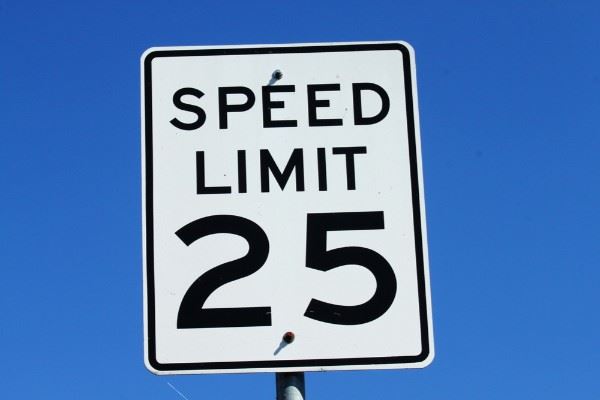
In California, as in many states, there are several methods of charging a driver with speeding. And, like most other states, speeding is one of the most common traffic tickets. CA Vehicle Codes (CVC) 22348- 22413 cover the various speed laws.
There are generally three types of speed laws: basic, absolute, and presumed. Given California’s “presumed” or prima facie law, you could be guilty even though there was no speed limit sign visible. However, the presumed speeding law allows many to escape a speeding ticket if the basis was only clocked speed in perfect conditions (see presumed law below).
Prima Facie Speed Law
The first is the basic or “prima facie” speed law. Cornell Law School’s Legal Information Institute (LII) defines it as “based on the first impression; accepted as correct until proved otherwise.”
Under CVC 22350, Speed Laws this requires all drivers to drive at a safe or reasonable speed given the weather, visibility, road conditions, ”and in no event at a speed which endangers the safety of persons or property.”
Tickets for this usually get issued after an accident. If you run into someone’s car because you did not have enough time to stop on a slippery road or on a foggy night, the LEO could argue you were going “too fast for conditions.”
In some cases, the LEO can even guess how fast you were going, and the judge will support them if they are an experienced officer. However, a rookie cop that speculates you were doing 52 in a 45 mph zone might have a tough time convincing a judge he or she could guess your speed to that degree of accuracy. That’s when having a lawyer helps to raise the question, “Were you going faster than the prudent speed?”
Absolute Speed Law
This one is too easy, if the sign says 55 mph and you drive 56 mph, you are subject to a speeding ticket.
Presumed Speed Law
The “presumed” speed law is a bit more complicated. When you are going 65 in a 55 mph zone, you are presumed to be speeding. In CA and other states that allow the “safe driving” defense, the driver can present evidence that disputes their driving at 65 was unsafe even though it is over the posted speed limit.
Rebutting the presumption is what you are doing. When every other action is safe on a bright, beautiful day with little traffic, why can’t you go 65? Many California judges will dismiss the ticket.
How Was Your Speed Established?
In CA, there are three methods to determine speed, Radar, Lidar, and pacing. Although your speed could be initially ascertained by an aircraft, a law enforcement vehicle must pace the vehicle for a specific distance to discover if it is indeed the car that was speeding or capture the car’s speed on radar.
The acronym RADAR is short for "radio detection and ranging." Radar can establish a vehicle’s speed with a “gun,” which is pointed at a vehicle and emits an ultra-high-frequency (UHF) radio wavelength, which bounces back from the car to establish its speed on a stationary vehicle-mounted device.
The acronym LIDAR is short for Light Detection and Ranging. It is used to verify a vehicle’s speed using “a detection system which works on the principle of radar, but uses light from a laser.”
Law enforcement officers use “pacing” or the act of following a vehicle for a minimum two-tenths of a mile while matching the other vehicle’s speed.
Any of these methods can get used in traffic court. However, merely marking off a spot on the highway, and measuring how long it takes a vehicle to pass through that distance with a stop watch is entrapment or a speed trap because of the inaccuracy put into play by possible human error starting and stopping the watch.
Consult a Traffic Ticket Attorney about a Shafter Ticket
When you get a ticket on I-5 or 46 in Shafter, the first thing you should do, after signing your ticket is write down everything you can remember about the stop. You never know which details might be needed to dismiss your ticket. Certainly, when there is no speed limit sign, it raises some doubt. Call Bigger & Harman, (661) 349-9300. Se habla Español (661) 349-9755.
Here’s what Aditya revealed about her speeding ticket, “When I received a speeding over 100 ticket everyone told me that's it…nothing more can be done. But not Mark. He took my case and kept the expectations clear. His highly professional team kept me informed and updated on strategies and next steps through the entire period. Even when the traffic court refused to amend it, Mark himself called me. His confidence kept me going. And his skill got the ticket Dismissed!! Many thanks to you Mark. For anyone who gets a ticket in Kern, Shafter or nearby areas. First thing to do is contact Mark Bigger.”
We can’t promise you the same results, but we have a track record of success with 100+ mph speeding tickets and all tickets for that matter. For the best traffic ticket attorney near Shafter, CA, give us a call.
Email, attorney@biggerharmanlaw.com or send us a personal message (pm) on Facebook.
References:
The 2018 CA Driver Handbook .pdf
Nolo Legal Encyclopedia, Fight Your Speeding Ticket: What Is the Law?
Cornell Law School’s Legal Information Institute (LII)
CVC 22350, Speed Laws
